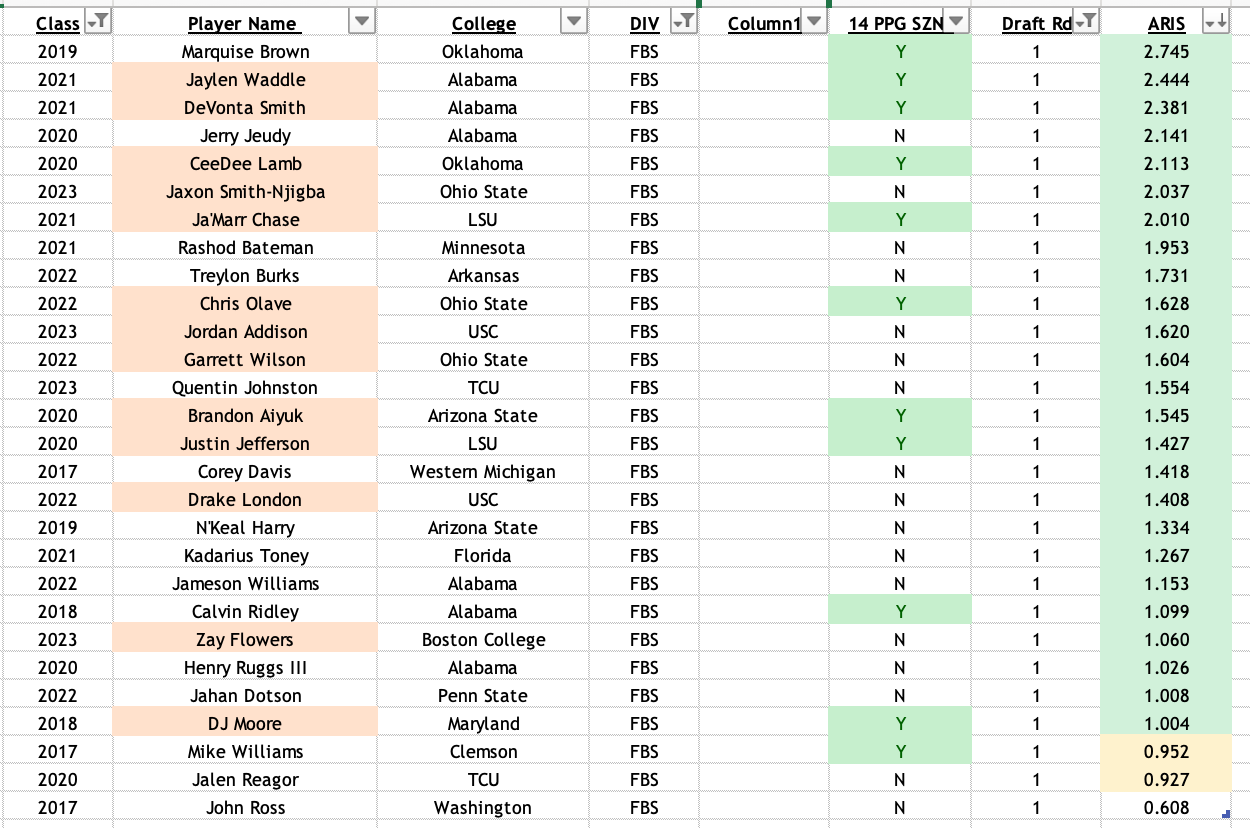Intro To ARIS: WR Edition
After the season wrapped up, I dove headfirst into the numbers and stories from the 2023 NFL season. One thing that kept popping up in my mind was how Puka Nacua seemed to sneak under the radar during the draft process. Sure, no one predicted his record-breaking rookie season, but why wasn't their more buzz about him? What did we miss that let him fly under the radar?
This line of inquiry led me to the concept of a unified metric that could capture both the productivity and efficiency of receivers in a single, comprehensive score. Thus, the idea of ARIS, or Aggregate Receiver Impact Score, was born. While ARIS aims to prevent future oversights by providing a holistic view of a player's impact, it's important to remember that it's just one piece of the puzzle. A prospect's profile is made up of many factors, including, but not limited to, athletic testing, film analysis, and draft capital.
This is not an end-all-be-all metric.
I initially developed ARIS with a focus on tight ends, but I have since expanded its application to include wide receivers. Early findings suggest that ARIS could have identified talents like Puca Nacua, Michael Pittman, Tank Dell, and Nico Collins during the draft process, helping us prioritize them in our fantasy drafts. As I continue refining the wide receiver version of ARIS, I am very excited about its potential to help identify priority wide receivers in rookie drafts.
Let’s dive in.
So, what is ARIS?
"ARIS," or the Aggregate Receiver Impact Score, is a specialized metric designed to assess the performance of wide receivers. This metric goes beyond traditional statistics like receptions and yardage to provide a more nuanced evaluation of a receiver's overall impact on the game.
*The inputs of what ARIS measures for WRs v TEs are slightly different. If you haven’t read the TE version, you can do so here.*
Here’s a breakdown of what ARIS measures:
Efficiency: ARIS first examines how effectively a receiver performs each time they run a route to catch a pass. Think of it as measuring a worker's productivity for every hour on the job. A receiver who consistently gains a significant number of yards per route is considered efficient.
Production: The metric then evaluates the receiver's overall contribution to their team's passing offense. This encompasses both the volume and quality of their work. It's similar to assessing an employee's performance based on their efficiency and total output over a project.
Versatility: For wide receivers, ARIS also takes into account their performance against different types of defensive coverage, such as man-to-man and zone coverage. This helps gauge a receiver's adaptability and effectiveness in various game situations.
Impact: Additionally, ARIS incorporates metrics like EPA per Pass Attempt and Adjusted Yards Per Team Play to measure a receiver's influence on the team's scoring potential and overall offensive success.
Combination: ARIS integrates these various aspects into a single comprehensive score. This balanced approach ensures that a receiver's value is assessed not just based on their individual stats but also on their broader contribution to the team's passing attack.
Purpose: ARIS's goal is to identify receivers who excel in productivity and efficiency. In terms of fantasy football, this metric can help managers make informed decisions when drafting players for their teams. The objective is to pick the players who will contribute the most fantasy points based on their on-field performances.
In summary, ARIS for wide receivers is about looking beyond basic stats to determine which players are truly invaluable in their role. By considering a range of factors, from efficiency to coverage adaptability, ARIS provides a holistic evaluation of a receiver's impact on the game.
In my WR database, I have 405 prospects since 2017 (including the 2024 class). This includes drafted players, undrafted players, FCS players, and FBS players. I believe in a ‘no stone unturned approach’ to evaluating prospects.
*The WR database only goes back to 2017 instead of 2015, like the rest of my databases, because some of the coverage-related metrics I use weren't tracked prior to 2017.*
Of the 405 prospects, 141 WRs have an ARIS score of 1.000 or greater.
Since 2017, there have been 31 different WRs to have a season of at least 14 PPG.
26/31 had an ARIS score of 1.000 or greater, and 30/31 had an ARIS score of .7750 or greater.
Of the current top 24 dynasty WRs (as of February 1), per FantasyCalc, 23/24 have an ARIS score greater than 1.000.
Nico Collins is the only T24 WR who doesn’t have an ARIS score greater than 1.000. He finds himself in a second-tier grouping I have identified as a score between .775 and 1.000. This grouping of WRs with an ARIS score between .775 and 1.000 might suggest players who could be valuable depth options or potential breakout candidates (stashes). This second tier comprises players who had specific roles that limited their ceiling but could still offer fantasy relevance. It's evident that players like Jalen Reagor, Alec Pierce, John Metchie, and Denzel Mims were overrated during their draft processes. Conversely, it's clear that players such as Nico Collins, Terry McLaurin, and Chris Godwin could have been identified as good stashes.
When we look deeper, we can see that all four players who had at least one 14PPG season were drafted in rounds 1-3. We can be cautiously optimistic about this list, but only about one out of every four players has ended up being successful.
Of the 405 WRs in my database, 206 have failed to at least achieve an ARIS score of .775 or higher. Hunter Renfrow is the only WR of those 206 (.0049%) with at least one 14PPG season.
Let's take a closer look at ARIS by filtering with draft capital.
Players drafted in round one since 2017.
Players drafted in round two since 2017.
Players drafted in round three since 2017.
Players drafted in rounds four and five since 2017.
Players drafted in rounds six and seven since 2017.
And finally, only the UDFAs who graded above a .775 since 2017.
Falling below the .775 threshold certainly raises a major red flag on a player’s prospect profile and should be considered the minimum threshold for the players we want to draft. However, a high ARIS score, although not a guarantee of success, indicates potential for fantasy relevance. It signifies that the player was efficient in college and made a significant contribution to their team's passing game.
Some of the data I use isn’t fully available yet for FCS players, so I have plugged in what I do have access to, and this is how they grade out. Cooper Kupp is the only successful WR from this group and was only one of two to grade above 1.000.
With scouting season well underway, this is how the 2024 rookie class stacks up.
First, let’s look at the top group.
No surprise to see the big three WRs of Harrison Jr, Nabers, and Odunze grade out well.
McConkey, Franklin, and Worthy are in that secod tier of WRs that also graded well.
Johnny Wilson > Keon Coleman
Javon Baker has been a popular name of late and shows up well here; Luke McCaffrey does as well. If they can land day two draft capital, they could be the two names that fly under the radar this year, similar to that of Rice and Dell last year.
Tyler Harrell surprisingly graded really well, but I think that is due to the lack of playing time in college. When he did play, he performed well, but he didn’t play much. Per PFF, he ran only 269 routes in 29 games played in college, which is roughly 9 routes per game, so a very small sample size. During Miami’s pro day, he ran a 4.29 forty and measured in at 6’0, 193 lbs. If he is drafted, even if it is late day three, he might be worth adding to the taxi squad as a priority waiver wire add.
Now, let’s take a look at the second group.
To recap what this group signifies - This grouping of WRs with an ARIS score between .775 and 1.000 might suggest players who could be valuable depth options or potential breakout candidates (stashes). This second tier might include players who had specific roles that limited their ceiling but still could provide fantasy relevance. With these WRs, we want to focus on the ones who are drafted in the first three rounds. According to recent consensus mock drafts - Corely, Washington, Wilson, Rice, McMillan, and Pearsall are the names we should be watching out for.
And then, finally, the group we should be avoiding.
Popular names to go in the first three rounds include Xavier Legette, Adonai Mitchell, Ja’lynn Polk, Brian Thomas Jr, Keon Coleman, and Jha’Quan Jackson.
Looking back at past WRs drafted in the first three rounds with an ARIS score of less than .775 - the list isn’t pretty.
Lastly, the FCS WRs from this class I have in my database.



















